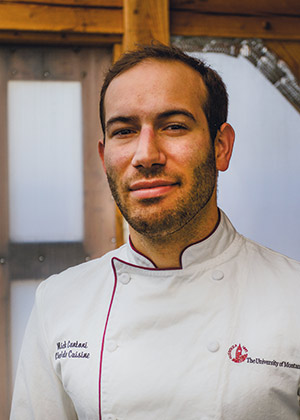Chef de Cuisine/Production Manager
University of Montana, Missoula
Educational Background: Associate degree in Culinary Arts from Johnson & Wales University
Years in foodservice: 14
Age: 29
 Nick CantoniFE&S: What drew you to the foodservice industry?
Nick CantoniFE&S: What drew you to the foodservice industry?
NC: I grew up with two parents who were chefs, so I inevitably learned a lot from them and cooked for myself when they weren't home. Fast-forward to high school, I worked at a pizza joint and then snagged a prep job at a country club. That's when I knew this was the career I wanted to pursue and went on to culinary school.
FE&S: What led you to the campus dining segment?
NC: The timing just happened to be right. I moved from Ohio to Montana looking for a fresh start, and although it took nearly a year of part-time jobs, a position at the University of Montana opened up and I jumped on it. My mother worked for the University of Akron at the time and highly recommended campus dining after working in the private sector for many years.
FE&S: What's the best career advice you have been given?
NC: "The arts are not a way to make a living. They are a very human way of making life more bearable. Practicing an art, no matter how well or badly, is a way to make your soul grow, for heaven's sake." That's a quote from Kurt Vonnegut, A Man Without a Country.
It's not exactly advice that I've been given, but it's advice I've taken nonetheless. Cooking is an art and a fantastic way to break the monotony life can throw at you. I may not cook at a restaurant, university or country club my whole life, but food will be involved in any career choice I make.
FE&S: What's an important lesson you've learned about working in this segment?
NC: One of the biggest eye-openers has been that people throw away a lot of food. It's unbelievable. UM Dining has implemented lots of ways to help reduce food waste, including getting rid of trays in the dining hall, using a software system to track food waste in our production kitchen and using a pulper and dehydrator. All post-consumer and kitchen-trim waste is converted into compost that's used at a local UM Dining-sponsored garden.
FE&S: What trends and future directions in campus dining are most exciting to you?
NC: Local and sustainable. There has been a huge push recently moving toward more sustainable practices and sourcing locally when possible. I believe the University of Montana is one of the leaders of that charge. Our operation purchases more than $1 million annually of Montana products, and as one of the purchasers for residential dining I am proud to contribute to a huge portion of that.
FE&S: Where do you see the biggest need for change or improvement?
NC: The biggest need is to move away from using so much commercially raised animal protein and toward Menus of Change-type initiatives with plant-forward thinking. It is not sustainable for the planet for us to continue our current eating habits.
FE&S: What's one of the biggest professional challenges you have overcome?
NC: I was diagnosed with Bell's palsy when I was 23. It goes away for most people in a couple of weeks; my case was very severe and still lingers 6 years later. I learned to deal with it eventually and after about a year I was basically back to looking "normal." I had to relearn everything having to do with facial muscles; eating, drinking, smiling, whistling, etc. That was tough.
FE&S: Complete this sentence as it relates to your campus dining program: "I really wish we could ..."
NC: ... build a new dining facility. Our current residential dining facility is very old and outdated, especially while our neighboring and competing university is expanding rapidly. We may serve the best university food in the state [see "Niche 2016 Best College Food rankings"], but without a facility to correspond, it doesn't get the recognition it should.
FE&S: What keeps you in this industry?
NC: Passion. Food is what I know best, and there's always an opportunity to grow and learn more. New and exciting techniques, such as sous vide, have invaded the culinary scene and allow for endless possibilities.




